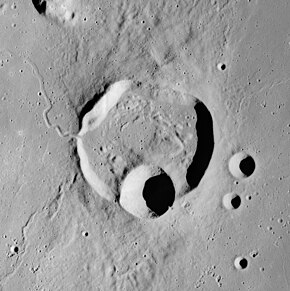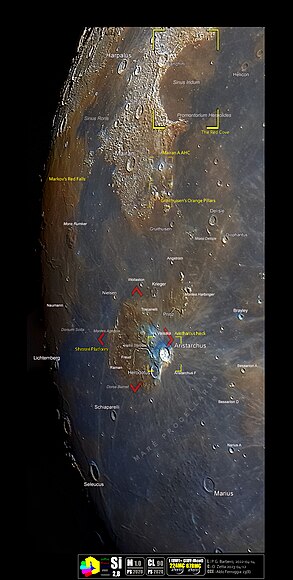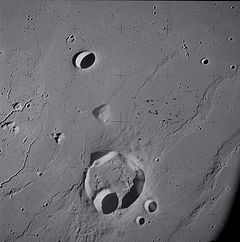 Apollo 15 image Apollo 15 image | |
| Coordinates | 29°01′N 45°37′W / 29.02°N 45.61°W / 29.02; -45.61 |
|---|---|
| Diameter | 22.87 km (14.21 mi) |
| Depth | 1.1 km |
| Colongitude | 46° at sunrise |
| Eponym | Johann N. Krieger |


Krieger is a lunar impact crater on the eastern part of the Oceanus Procellarum. It is located to the north-northwest of the flooded crater Prinz, and north-northeast of the prominent ray crater Aristarchus. To the northwest lies the small Wollaston. The crater was formally named in 1935.
In the past the floor of Krieger has been flooded by basaltic lava, leaving only a low, circular, somewhat polygonal ridge formed by the rim. The southern rim is broken across by the small Van Biesbroeck, and there is a small gap in the western rim. A meandering rille leads away from this break toward the northwest.
Krieger is a crater of Upper (Late) Imbrian age.
Nearby craters
Two tiny craters next to the eastern rim have been designated Rocco and Ruth. Rocco was previously designated as Krieger D before being named by the IAU.
| Crater | Longitude | Latitude | Diameter | Name source |
|---|---|---|---|---|
| Rocco | 28.9° N | 45.0° W | 5 km | Italian masculine name |
| Ruth | 28.7° N | 45.1° W | 3 km | Jewish feminine name |
The nearby surface to the southwest contains a number of rilles belonging to the Rimae Aristarchus and Rimae Prinz rille systems. Further to the east-southeast are the Montes Harbinger mountains.
Satellite craters
By convention these features are identified on lunar maps by placing the letter on the side of the crater midpoint that is closest to Krieger.
| Krieger | Latitude | Longitude | Diameter |
|---|---|---|---|
| C | 27.7° N | 44.6° W | 4 km |
The following craters have been renamed by the IAU.
- Krieger B — See Van Biesbroeck (crater).
References
- "Krieger". Gazetteer of Planetary Nomenclature. IAU/NASA/USGS. Retrieved 6 September 2023.
- The geologic history of the Moon. USGS Professional Paper 1348. By Don E. Wilhelms, John F. McCauley, and Newell J. Trask. U.S. Government Printing Office, Washington: 1987. Table 11.2.
- Andersson, L. E.; Whitaker, E. A. (1982). NASA Catalogue of Lunar Nomenclature. NASA RP-1097.
- Blue, Jennifer (July 25, 2007). "Gazetteer of Planetary Nomenclature". USGS. Retrieved 2007-08-05.
- Bussey, B.; Spudis, P. (2004). The Clementine Atlas of the Moon. New York: Cambridge University Press. ISBN 978-0-521-81528-4.
- Cocks, Elijah E.; Cocks, Josiah C. (1995). Who's Who on the Moon: A Biographical Dictionary of Lunar Nomenclature. Tudor Publishers. ISBN 978-0-936389-27-1.
- McDowell, Jonathan (July 15, 2007). "Lunar Nomenclature". Jonathan's Space Report. Retrieved 2007-10-24.
- Menzel, D. H.; Minnaert, M.; Levin, B.; Dollfus, A.; Bell, B. (1971). "Report on Lunar Nomenclature by the Working Group of Commission 17 of the IAU". Space Science Reviews. 12 (2): 136–186. Bibcode:1971SSRv...12..136M. doi:10.1007/BF00171763. S2CID 122125855.
- Moore, Patrick (2001). On the Moon. Sterling Publishing Co. ISBN 978-0-304-35469-6.
- Price, Fred W. (1988). The Moon Observer's Handbook. Cambridge University Press. ISBN 978-0-521-33500-3.
- Rükl, Antonín (1990). Atlas of the Moon. Kalmbach Books. ISBN 978-0-913135-17-4.
- Webb, Rev. T. W. (1962). Celestial Objects for Common Telescopes (6th revised ed.). Dover. ISBN 978-0-486-20917-3.
- Whitaker, Ewen A. (1999). Mapping and Naming the Moon. Cambridge University Press. ISBN 978-0-521-62248-6.
- Wlasuk, Peter T. (2000). Observing the Moon. Springer. ISBN 978-1-85233-193-1.
External links
- LTO-39A1 Krieger — L&PI topographic map of the crater and vicinity.
- 39A1S1(50) Van Biesbroeck, detailed map of Krieger and Van Biesbroeck
- Wood, Chuck (August 31, 2007). "An Invisible Lava Flow". Lunar Photo of the Day. Archived from the original on September 29, 2007. Retrieved 2007-09-04.